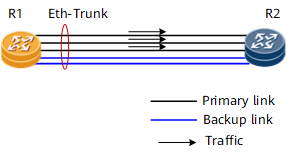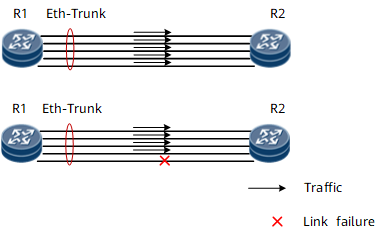Eth-Trunk Load Balancing
Traffic can be load-balanced among active trunk member links to provide higher link reliability and higher bandwidth than each individual link.
Static LACP mode: a link aggregation mode that uses the Link Aggregation Control Protocol (LACP) to negotiate parameters and select active links based on the IEEE802.3ad standard. In static LACP mode, LACP determines the numbers of active and inactive links in a link aggregation group. It is also called the M:N mode, with M and N indicating the number of primary and backup links, respectively. This mode provides higher link reliability and allows load balancing to be performed among M links.
On the network shown in Figure 1, three primary links and two backup links with the same attributes exist between two devices. Traffic is load-balanced among the three primary links, but not along the two backup links. The actual bandwidth of the aggregated link is the sum of the bandwidths of the three primary links.
If a link in M links fails, LACP selects one from the N backup links to replace the faulty one to retain M:N backup. The actual link bandwidth is still the sum of the bandwidths of the M primary links.
If a link cannot be found in the backup links to replace the faulty link and the number of member links in the Up state falls below the configured lower threshold of active links, the Eth-Trunk interface goes Down. Then all member interfaces in the Eth-Trunk interface no longer forward data.
An Eth-Trunk interface working in static LACP mode can contain member interfaces at different rates, in different duplex modes, and on different boards. Eth-Trunk member interfaces at different rates cannot forward data at the same time. Member interfaces in half-duplex mode cannot forward data.
Manual load balancing mode: In this mode, you must manually create an Eth-Trunk interface, add interfaces to the Eth-Trunk interface, and specify active member interfaces. LACP is not involved. All active member interfaces forward data and perform load balancing.
Traffic can be evenly load-balanced among all member interfaces. Alternatively, you can set the weight for each member interface to implement uneven load balancing; in this manner, the interface that has a larger weight transmits a larger volume of traffic. If an active link in a link aggregation group fails, traffic is balanced among the remaining active links evenly or based on weights, as shown in Figure 2.
An Eth-Trunk interface working in manual load balancing mode can contain member interfaces at different rates, in different duplex modes, and on different boards.

